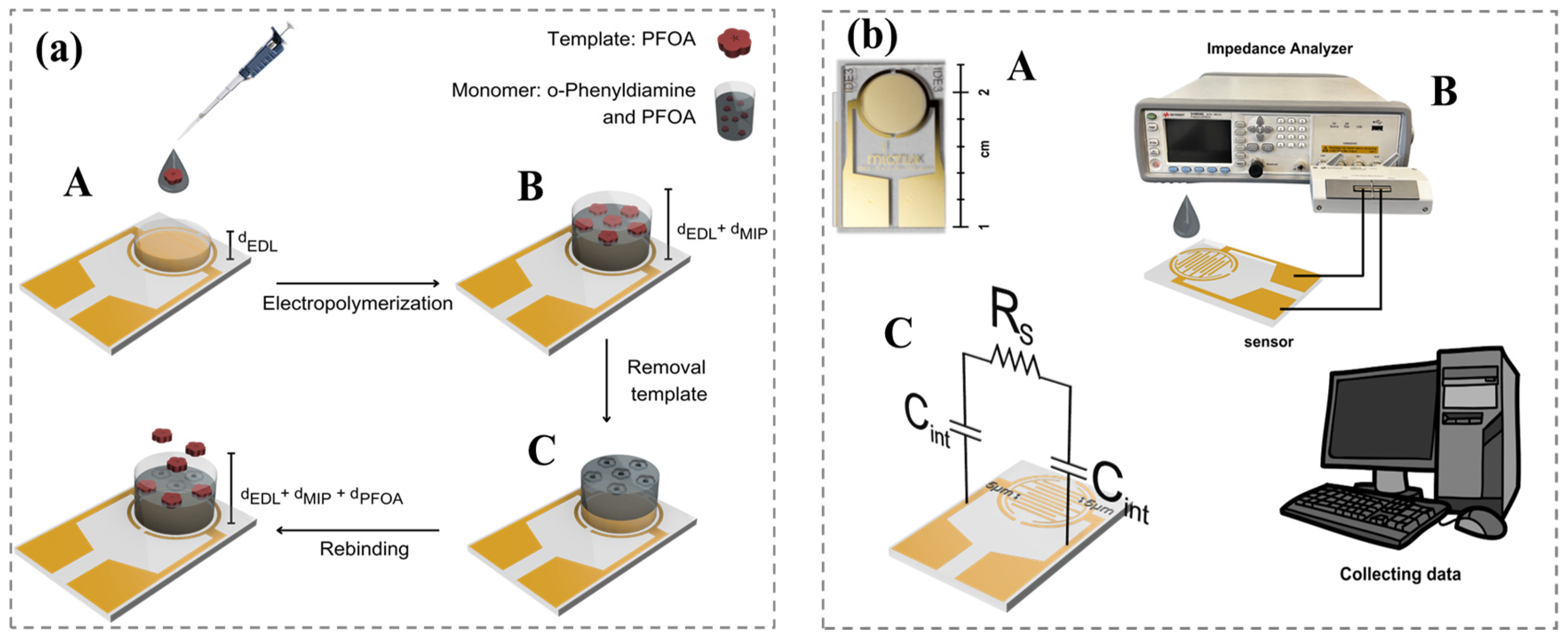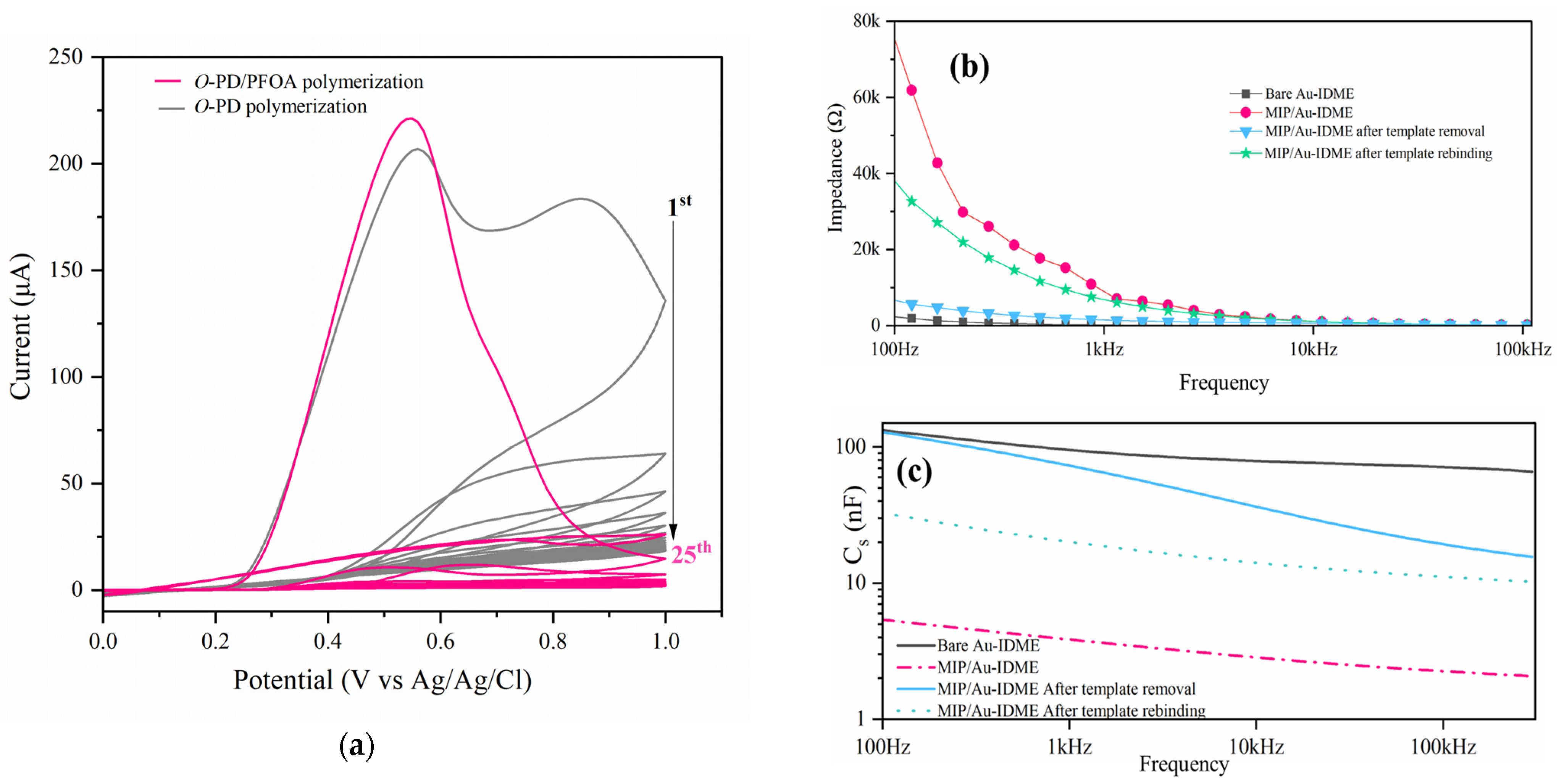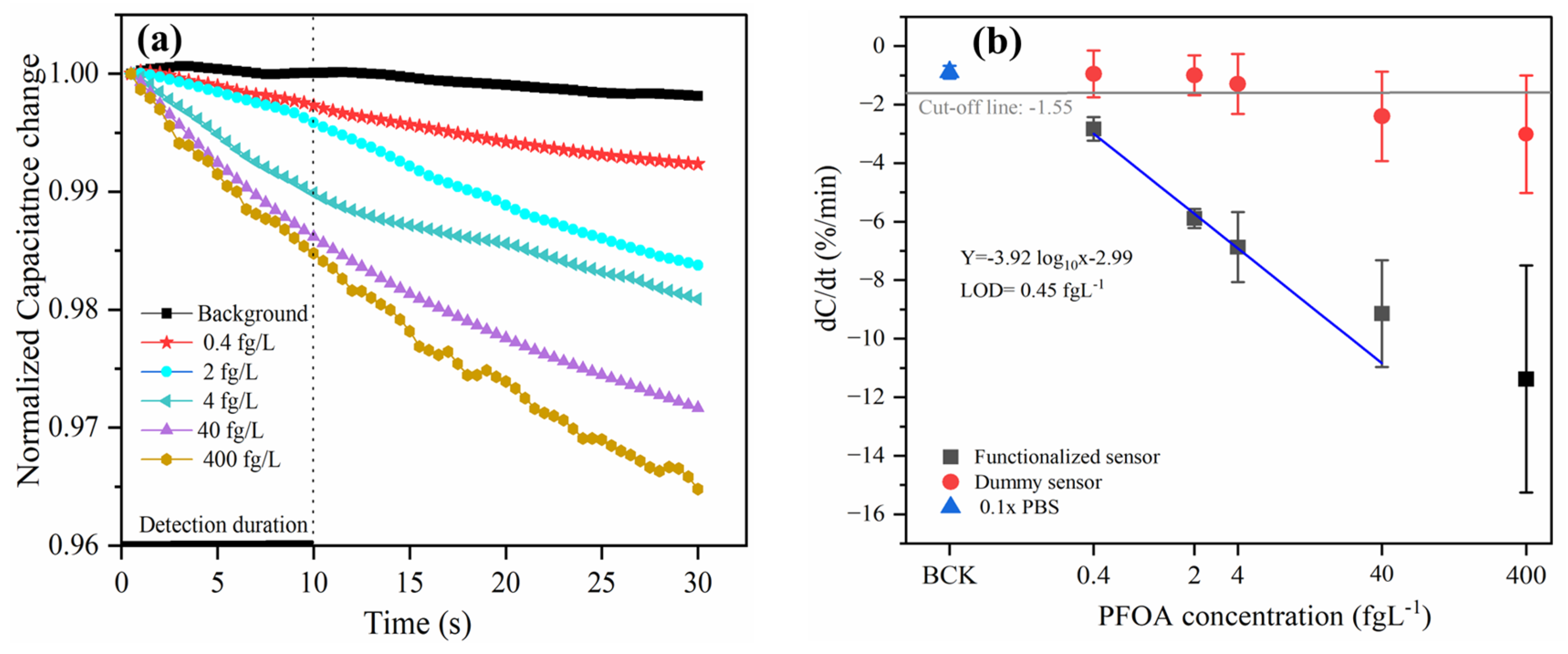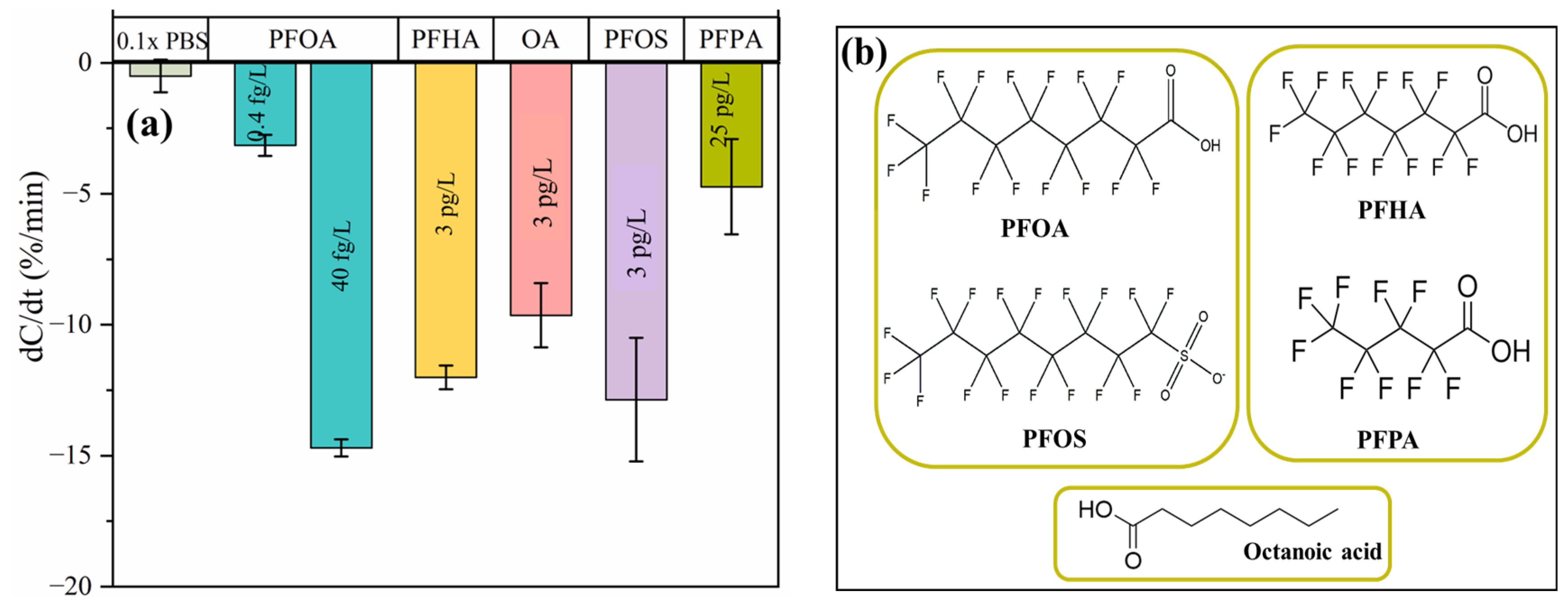Rapid and Ultrasensitive Sensor for Point-of-Use Detection of Perfluorooctanoic Acid Based on Molecular Imprinted Polymer and AC Electrothermal Effect
Abstract
1. Introduction
2. Materials and Methods
2.1. Fabrication of MIP/Au-IDME
2.2. Measurement Process and Data Analysis
3. Results and Discussion
3.1. Molecularly Imprinted Poly o-PD Preparation on Au-IDMEs
3.2. Interfacial Capacitance Sensing
3.3. PFOA Enrichment by ACET Effect
3.4. Electrical Characterization of Functionalized Sensor
3.5. Dose–Response Curve
3.6. Selectivity Study
3.7. Imprinting Factor Investigation
4. Conclusions
Author Contributions
Funding
Data Availability Statement
Acknowledgments
Conflicts of Interest
References
- Fenton, S.E.; Ducatman, A.; Boobis, A.; DeWitt, J.C.; Lau, C.; Ng, C.; Smith, J.S.; Roberts, S.M. Per- and Polyfluoroalkyl Substance Toxicity and Human Health Review: Current State of Knowledge and Strategies for Informing Future Research. Environ. Toxicol. Chem. 2021, 40, 606–630. [Google Scholar] [CrossRef] [PubMed]
- Lee, J.; Kim, C.; Liu, C.; Wong, M.S.; Cápiro, N.L.; Pennell, K.D.; Fortner, J.D. Ultra-High Capacity, Multifunctional Nanoscale Sorbents for PFOA and PFOS Treatment. npj Clean Water 2023, 6, 62. [Google Scholar] [CrossRef]
- Li, F.; Duan, J.; Tian, S.; Ji, H.; Zhu, Y.; Wei, Z.; Zhao, D. Short-Chain per- and Polyfluoroalkyl Substances in Aquatic Systems: Occurrence, Impacts and Treatment. Chem. Eng. J. 2020, 380, 122506. [Google Scholar] [CrossRef]
- Khan, R.; Uygun, Z.O.; Andreescu, D.; Andreescu, S. Sensitive Detection of Perfluoroalkyl Substances Using MXene–AgNP-Based Electrochemical Sensors. ACS Sens. 2024, 9, 3403–3412. [Google Scholar] [CrossRef]
- Schultz, M.M.; Barofsky, D.F.; Field, J.A. Quantitative Determination of Fluorotelomer Sulfonates in Groundwater by LC MS/MS. Environ. Sci. Technol. 2004, 38, 1828–1835. [Google Scholar] [CrossRef]
- Menger, R.F.; Funk, E.; Henry, C.S.; Borch, T. Sensors for Detecting Per- and Polyfluoroalkyl Substances (PFAS): A Critical Review of Development Challenges, Current Sensors, and Commercialization Obstacles. Chem. Eng. J. 2021, 417, 129133. [Google Scholar] [CrossRef]
- Park, J.; Yang, K.-A.; Choi, Y.; Choe, J.K. Novel SsDNA Aptamer-Based Fluorescence Sensor for Perfluorooctanoic Acid Detection in Water. Environ. Int. 2022, 158, 107000. [Google Scholar] [CrossRef]
- Suwannakot, P.; Lisi, F.; Ahmed, E.; Liang, K.; Babarao, R.; Gooding, J.J.; Donald, W.A. Metal–Organic Framework-Enhanced Solid-Phase Microextraction Mass Spectrometry for the Direct and Rapid Detection of Perfluorooctanoic Acid in Environmental Water Samples. Anal. Chem. 2020, 92, 6900–6908. [Google Scholar] [CrossRef]
- Zhang, F.; Zheng, Y.; Liang, J.; Long, S.; Chen, X.; Tan, K. A Simple and Highly Sensitive Assay of Perfluorooctanoic Acid Based on Resonance Light Scattering Technique. Spectrochim. Acta A Mol. Biomol. Spectrosc. 2016, 159, 7–12. [Google Scholar] [CrossRef]
- Sharma, P.S.; Pietrzyk-Le, A.; D’Souza, F.; Kutner, W. Electrochemically Synthesized Polymers in Molecular Imprinting for Chemical Sensing. Anal. Bioanal. Chem. 2012, 402, 3177–3204. [Google Scholar] [CrossRef]
- Mwanza, C.; Zhang, W.-Z.; Mulenga, K.; Ding, S.-N. Advancing Green Chemistry in Environmental Monitoring: The Role of Electropolymerized Molecularly Imprinted Polymer-Based Electrochemical Sensors. Green Chem. 2024, 26, 11490–11517. [Google Scholar] [CrossRef]
- Wei, Y.; Liu, H.; Wang, S.; Yu, K.; Wang, L. A Portable Molecularly Imprinted Polymer-Modified Microchip Sensor for the Rapid Detection of Perfluorooctanoic Acid. Analyst 2023, 148, 3851–3859. [Google Scholar] [CrossRef]
- Tabar, F.A.; Lowdon, J.W.; Caldara, M.; Cleij, T.J.; Wagner, P.; Diliën, H.; Eersels, K.; van Grinsven, B. Thermal Determination of Perfluoroalkyl Substances in Environmental Samples Employing a Molecularly Imprinted Polyacrylamide as a Receptor Layer. Environ. Technol. Innov. 2023, 29, 103021. [Google Scholar] [CrossRef]
- Gong, J.; Fang, T.; Peng, D.; Li, A.; Zhang, L. A Highly Sensitive Photoelectrochemical Detection of Perfluorooctanic Acid with Molecularly Imprined Polymer-Functionalized Nanoarchitectured Hybrid of AgI–BiOI Composite. Biosens. Bioelectron. 2015, 73, 256–263. [Google Scholar] [CrossRef]
- Zheng, L.; Zheng, Y.; Liu, Y.; Long, S.; Du, L.; Liang, J.; Huang, C.; Swihart, M.T.; Tan, K. Core-Shell Quantum Dots Coated with Molecularly Imprinted Polymer for Selective Photoluminescence Sensing of Perfluorooctanoic Acid. Talanta 2019, 194, 1–6. [Google Scholar] [CrossRef]
- Pitruzzella, R.; Arcadio, F.; Perri, C.; Del Prete, D.; Porto, G.; Zeni, L.; Cennamo, N. Ultra-Low Detection of Perfluorooctanoic Acid Using a Novel Plasmonic Sensing Approach Combined with Molecularly Imprinted Polymers. Chemosensors 2023, 11, 211. [Google Scholar] [CrossRef]
- Chen, S.; Li, A.; Zhang, L.; Gong, J. Molecularly Imprinted Ultrathin Graphitic Carbon Nitride Nanosheets–Based Electrochemiluminescence Sensing Probe for Sensitive Detection of Perfluorooctanoic Acid. Anal. Chim. Acta 2015, 896, 68–77. [Google Scholar] [CrossRef]
- Rehman, A.U.; Crimi, M.; Andreescu, S. Current and Emerging Analytical Techniques for the Determination of PFAS in Environmental Samples. Trends Environ. Anal. Chem. 2023, 37, e00198. [Google Scholar] [CrossRef]
- Amin, N.; Chen, J.; He, Q.; Schwartz, J.S.; Wu, J.J. Ultra-Sensitive and Rapid Detection of Perfluorooctanesulfonic Acid by a Capacitive Molecularly-Imprinted-Polymer Sensor Integrated with AC Electrokinetic Acceleration. Sens. Actuators B Chem. 2024, 420, 136464. [Google Scholar] [CrossRef]
- Karimian, N.; Stortini, A.M.; Moretto, L.M.; Costantino, C.; Bogialli, S.; Ugo, P. Electrochemosensor for Trace Analysis of Perfluorooctanesulfonate in Water Based on a Molecularly Imprinted Poly (o-Phenylenediamine) Polymer. ACS Sens. 2018, 3, 1291–1298. [Google Scholar] [CrossRef]
- Zhang, J.; Qi, H.; Wu, J.J.; Mao, X.; Zhang, H.; Amin, N.; Xu, F.; Dong, C.; Wang, C.; Wang, P.; et al. Disposable Peptidoglycan-Specific Biosensor for Noninvasive Real-Time Detection of Broad-Spectrum Gram-Positive Bacteria in Exhaled Breath Condensates. Anal. Chem. 2024, 96, 9817–9825. [Google Scholar] [CrossRef]
- Schmickler, W. Electronic Effects in the Electric Double Layer. Chem. Rev. 1996, 96, 3177–3200. [Google Scholar] [CrossRef] [PubMed]
- Mirzajani, H.; Cheng, C.; Vafaie, R.H.; Wu, J.; Chen, J.; Eda, S.; Aghdam, E.N.; Ghavifekr, H.B. Optimization of ACEK-Enhanced, PCB-Based Biosensor for Highly Sensitive and Rapid Detection of Bisphenol a in Low Resource Settings. Biosens. Bioelectron. 2022, 196, 113745. [Google Scholar] [CrossRef] [PubMed]
- Meng, J.; Huang, J.; Oueslati, R.; Jiang, Y.; Chen, J.; Li, S.; Dai, S.; He, Q.; Wu, J. A Single-Step DNAzyme Sensor for Ultra-Sensitive and Rapid Detection of Pb2+ Ions. Electrochim. Acta 2021, 368, 137551. [Google Scholar] [CrossRef]
- Wu, J. Interactions of Electrical Fields with Fluids: Laboratory-on-a-Chip Applications. IET Nanobiotechnol. 2008, 2, 14–27. [Google Scholar] [CrossRef]
- Hagness, D.E.; Yang, Y.; Tilley, R.D.; Gooding, J.J. The Application of an Applied Electrical Potential to Generate Electrical Fields and Forces to Enhance Affinity Biosensors. Biosens. Bioelectron. 2023, 238, 115577. [Google Scholar] [CrossRef]
- Sasaki, N. Recent Applications of AC Electrokinetics in Biomolecular Analysis on Microfluidic Devices. Anal. Sci. 2012, 28, 3–8. [Google Scholar] [CrossRef]
- Salari, A.; Thompson, M. Recent Advances in AC Electrokinetic Sample Enrichment Techniques for Biosensor Development. Sens. Actuators B Chem. 2018, 255, 3601–3615. [Google Scholar] [CrossRef]
- Amin, N.; Almasi, A.; Ozer, T.; Henry, C.S.; Hosseinzadeh, L.; Keshavarzi, Z. Recent Advances of Optical Biosensors in Veterinary Medicine: Moving Towards the Point of Care Applications. Curr. Top. Med. Chem. 2023, 23, 2242–2265. [Google Scholar] [CrossRef]
- Amin, N.; Chen, J.; Cao, Q.; Qi, H.; Zhang, J.; He, Q.; Wu, J.J. Low-Cost Portable Sensor for Rapid and Sensitive Detection of Pb2+ Ions Using Capacitance Sensing Integrated with Microfluidic Enrichment. Microchim. Acta 2024, 191, 718. [Google Scholar] [CrossRef]
- Amin, N.; Afkhami, A.; Hosseinzadeh, L.; Amin, A.; Madrakian, T. Flexible Electrospun Nanofibrous Film Integrated with Fluorescent Carbon Dots for Smartphone-Based Detection and Cellular Imaging Application. Spectrochim. Acta A Mol. Biomol. Spectrosc. 2021, 260, 119944. [Google Scholar] [CrossRef] [PubMed]
- Li, H.-H.; Wang, H.-H.; Li, W.-T.; Fang, X.-X.; Guo, X.-C.; Zhou, W.-H.; Cao, X.; Kou, D.-X.; Zhou, Z.-J.; Wu, S.-X. A novel electrochemical sensor for epinephrine based on three dimensional molecularly imprinted polymer arrays. Sens. Actuators B Chem. 2016, 222, 1127. [Google Scholar] [CrossRef]
- Pilvenyte, G.; Ratautaite, V.; Boguzaite, R.; Ramanavicius, S.; Chen, C.-F.; Viter, R.; Ramanavicius, A. Molecularly Imprinted Polymer-Based Electrochemical Sensors for the Diagnosis of Infectious Diseases. Biosensors 2023, 13, 620. [Google Scholar] [CrossRef] [PubMed]




| Method | Sensor Design | LOD (ngL−1) | Dynamic Range (ngL−1) | Assay Time | Ref. |
|---|---|---|---|---|---|
| DPV 1 | Au/Cu2O@C@NiCo2O4/MIP | 19.46 | 207–4140 | 15 min | [12] |
| Heat transfer | MIP-poly acrylamide | 8.0 | 40–2 × 105 | NM 2 | [13] |
| Photoelectrochemistry | AgI–BiOINFs 3/poly acrylamide | 10 | 20–106 | 20 min | [14] |
| Fluorescence | CdTe@CdS-based/poly APTES 4 | 104 | 105–6 × 106 | 5 min | [15] |
| SPR 5 | Poly VBTe 6 and PFDA 7 | 0.81 | 1–750 | NM | [16] |
| ECL 8 | GCN 9 nanosheets/poly pyrrole | 10 | 20–4 × 105 | NM | [17] |
| Capacitance | MIP/Au-IDMEs/poly o-PD 10 | 4.5 × 10−7 | 4 × 10−7–4 × 10−5 | 10 s | This work |
| PFOA Concentration | dc/dtMIP | dc/dtNIP | IF |
|---|---|---|---|
| 0.4 (fg/L) | −2.83 | −0.95 | 2.98 |
| 2 (fg/L) | −5.89 | −1 | 5.9 |
| 4 (fg/L) | −6.87 | −1.3 | 5.3 |
Disclaimer/Publisher’s Note: The statements, opinions and data contained in all publications are solely those of the individual author(s) and contributor(s) and not of MDPI and/or the editor(s). MDPI and/or the editor(s) disclaim responsibility for any injury to people or property resulting from any ideas, methods, instructions or products referred to in the content. |
© 2025 by the authors. Licensee MDPI, Basel, Switzerland. This article is an open access article distributed under the terms and conditions of the Creative Commons Attribution (CC BY) license (https://creativecommons.org/licenses/by/4.0/).
Share and Cite
Amin, N.; Chen, J.; Nguyen, N.S.; He, Q.; Schwartz, J.; Wu, J.J. Rapid and Ultrasensitive Sensor for Point-of-Use Detection of Perfluorooctanoic Acid Based on Molecular Imprinted Polymer and AC Electrothermal Effect. Micromachines 2025, 16, 283. https://doi.org/10.3390/mi16030283
Amin N, Chen J, Nguyen NS, He Q, Schwartz J, Wu JJ. Rapid and Ultrasensitive Sensor for Point-of-Use Detection of Perfluorooctanoic Acid Based on Molecular Imprinted Polymer and AC Electrothermal Effect. Micromachines. 2025; 16(3):283. https://doi.org/10.3390/mi16030283
Chicago/Turabian StyleAmin, Niloufar, Jiangang Chen, Ngoc Susie Nguyen, Qiang He, John Schwartz, and Jie Jayne Wu. 2025. "Rapid and Ultrasensitive Sensor for Point-of-Use Detection of Perfluorooctanoic Acid Based on Molecular Imprinted Polymer and AC Electrothermal Effect" Micromachines 16, no. 3: 283. https://doi.org/10.3390/mi16030283
APA StyleAmin, N., Chen, J., Nguyen, N. S., He, Q., Schwartz, J., & Wu, J. J. (2025). Rapid and Ultrasensitive Sensor for Point-of-Use Detection of Perfluorooctanoic Acid Based on Molecular Imprinted Polymer and AC Electrothermal Effect. Micromachines, 16(3), 283. https://doi.org/10.3390/mi16030283








